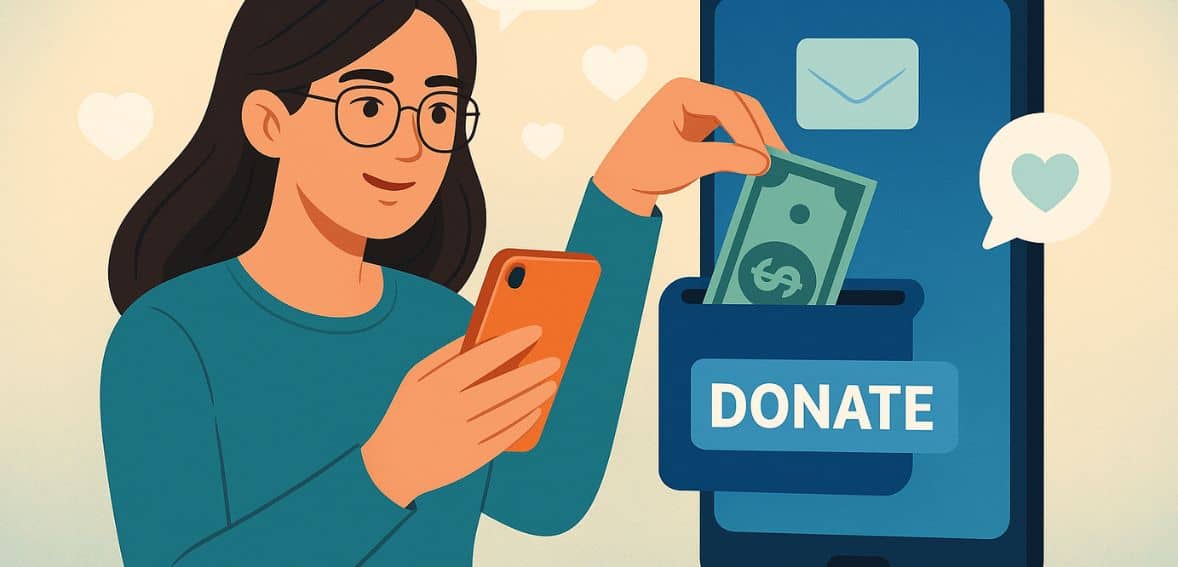
By Zackary Rhodes August 5, 2025
Charities and nonprofits are under more pressure than ever in 2025 to innovate their fundraising strategies. Since the 2010 Haiti earthquake campaign, text-to-give—in which contributors send a keyword or amount via SMS to donate—has become a trendy tool. Once thought to be the future of micro-donations, text-to-give is renowned for its speed and ease of use.
However, organizations today are considering whether its effect has diminished or if it still has an impact. Recent data and real-world experiences show that while it can still be powerful in specific settings, its broader utility now depends heavily on strategy, context, and integration into modern mobile fundraising architectures.
Why Text-to-Give Gained Prominence

Text-to-give was a significant advancement in the effectiveness of emergency fundraising in the early 2010s. In just a few months, the Red Cross raised tens of millions of dollars by asking people to “Text HAITI to 90999.” Appealing to ease and urgency—no website, no sign-up, just a smartphone and a few seconds—was the foundation of this success.
The idea was successful because it made it easier to give. Organizations eventually started using text campaigns for pop-up events and galas, which frequently included on-screen recognition based on audience participation. Many nonprofits now ask, “Where and when does it work best now?” rather than, “Can this work?”
Supportive Data: Still Promising—With Caveats
According to recent fundraising analyses, SMS campaigns can still have a significant impact in some situations. About 98 percent of messages are opened, and 90 percent of them are read in three minutes or less—a responsiveness that email cannot match. In line with early post-pandemic norms, the average text gift is approximately $107.
Since 2018, mobile donations have increased by more than 200 percent, and many donors use mobile platforms to find nonprofits for the first time. Notwithstanding this increase, mobile conversion rates are still lower than desktop ones (about 8% versus higher desktop rates), and the average size of a mobile gift is only $79–83 as opposed to $118–137 on desktop platforms.
These figures confirm that SMS is still a highly visible channel, but it is not always effective in the absence of mobile-optimized procedures. Long-term stewardship is further limited by the pure text-to-give flows’ lack of branding and donor data collection. The result is often one-time donors who aren’t connected to recurring giving or ongoing campaigns.
Where SMS Campaigns Still Shine

It’s becoming clear that text-to-give works best in situations that are strictly regulated, such as large-scale awareness campaigns, live appeals, disaster response, or fundraising events. Audiences are eager to participate in gala settings, and competitive giving is prompted by real-time updates shown on screens.
Connecting immediate intention to longer-term commitment can also be accomplished through text-to-pledge, in which donors make a pledge via SMS and finish the gift later. Timing is crucial in crisis relief efforts.
Supporters act quickly when they sense urgency and receive a simple keyword text. These are ideal for businesses with variable cash flows because many platforms still provide donation receipts in a matter of days or weeks.
Key Limitations in 2025 Context
Text-to-give has ongoing issues in spite of its advantages. Only the donor’s phone number and donation amount are usually collected. This implies that it is difficult to encourage recurring giving and that social or email segmentation is practically impossible. The campaign’s messaging is very limited, which leaves little opportunity for brand identity or storytelling—elements that foster trust and motivate bigger gifts.
Limits on transactions are also important. Organizations frequently lose out when cell carriers set donation caps of $5 to $25 per gift. Meanwhile, in emergencies, processing delays—which can last up to 90 days—can impair nonprofit cash flow. Because of this, text-to-give is less desirable for broad, continuous appeals where repeat engagement, multi-channel storytelling, and richer donor data are essential.
A holistic, Multi-Channel Strategy Wins Today
Today’s top-performing companies view SMS as a single channel within a multi-channel fundraising ecosystem. According to findings from mission-led nonprofits, there is a noticeable improvement when SMS is integrated with web forms, social media fundraising, and email. Sending brief, customized messages in between requests, known as cultivation texts, can increase average donation sizes and lower donor churn.
Donors feel seen rather than asked for when text messages contain stories, impact updates, and expressions of gratitude. Segmented messaging is made possible by modern platforms. While a first-time attendee receives a brief link to make an online donation, a longtime supporter may receive a text message with a story-based appeal.
When the messaging is relevant, both audiences react. Nonprofits can transform quick text exchanges into ongoing engagement by combining SMS with mobile-responsive websites and integrated CRMs.
Evolving Technologies Influencing 2025 SMS Use

The effectiveness of SMS is changing as a result of platform modifications and increased regulations. More stringent text filtering was added in Apple’s iOS 26 update, which directs unknown senders to filtered folders without alerting them. This could result in a significant loss of revenue for political campaigns, as 70 percent of small-dollar contributions are sent by text.
While nonprofits might not be directly impacted, donor outreach through SMS now faces deliverability challenges and more stringent carrier scrutiny. Personalized messages, mobile forms that are generated after a keyword, and one-click digital wallets are all made possible by the richer integrations provided by platforms such as Donorbox, Rally, and Tatango on the fundraising tech side.
These contemporary flows promote giving outside of the carrier billing model, in contrast to earlier implementations. Nonprofits must, however, select tools that facilitate data collection, storytelling, and brand identity—not just a quick SMS pipeline.
Advice From Nonprofit Practitioners
According to community insight, text campaigns are only effective when they serve a larger goal. According to Reddit users and nonprofit executives, text-to-give works best during highly contextual appeals or at events rather than as a stand-alone project. At a gala, one group used live-streamed text pledges to raise $35,000.
Other nonprofit executives stress that text campaigns that use ambiguous calls to action or have no bearing on the organization’s mission eventually fall short in terms of donor mobilization. Text users warn that aggressive messaging and an abundance of options can turn people off.
Simple, concise messages under 160 characters, clear opt-in communication, and a reasonable frequency (no more than one or two requests per month) all help prevent unsubscribe churn and the perception of spam. Ultimately, text-to-give is a tool—effective in select use cases, but not a universal fix for fundraising gaps.
Toward Smarter Fundraising in 2025
When assessing text-to-give, consider both its present advantages and disadvantages. Strategically use SMS for urgent appeals, disaster relief, and live events where visibility and rapidness are crucial. A mobile-responsive link and enrollment in larger donor flows, like email campaigns or programs that help nonprofits manage recurring donations, should be included in every SMS.
Don’t use text to replace relationship-building or storytelling. Create campaigns carefully by using stories to build emotional connections, personalizing messaging, and expressing gratitude often. Sort your SMS list into segments according to past donations and adjust your targeting accordingly. Make use of software that monitors engagement, uptime, and repeat giving in addition to one-time gift counts.
To put it briefly, text-to-give is still effective—but only when used as a component of a thoughtful, donor-centered strategy. SMS turns into an invitation to a long-term, mission-driven relationship when technology, data, communication, and context all come together. Effectiveness in 2025 will be about conversation, care, and integration rather than novelty.
Generational Shifts and Donor Expectations

Donor expectations are changing along with digital behavior. Younger Millennials and Gen Z, who now make up a significant amount of the giving population, demand a smooth user experience, personalization, and instant satisfaction. They react favorably to text campaigns, but only when combined with follow-through, impact-driven storytelling, and transparency.
A simple “thank you” note is no longer adequate. Whether their funds were used to support a grassroots project, dig a well, or save a dog, they want to know exactly where their money went. This is where text-to-give campaigns can be very effective if they are used to engage and inform in addition to soliciting.
Nowadays, some nonprofits share images, testimonies, or video summaries via automated follow-ups that happen days or weeks after the initial text donation. This raises the likelihood of further contributions in addition to confirming the donor’s decision. When used as a storytelling tool instead of a transaction tool, SMS can serve as a link between new donors and seasoned community members. It draws the donor into a story, and stories are what motivate generosity in the modern era.
Conclusion: Reimagining What “Effective” Means in 2025
So, are text-to-give campaigns still effective in 2025? The answer is yes, with conditions. Their ability to fit into a larger donor journey is what makes them strong today, not just their speed or novelty. Thoughtful follow-up is what creates enduring support, even though a single text can inspire a donation. SMS is still useful, but not as a one-time fix.
Effectiveness in 2025 entails employing mobile storytelling, delivering messages at the right moment, and consistently expressing sincere gratitude. Although text-to-give isn’t the newest tool, it’s still one of the most intimate and emotionally impactful ways to connect when done well. In a noisy digital world, a sincere, well-timed message can still cut through—and that’s worth holding onto.